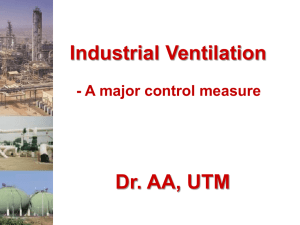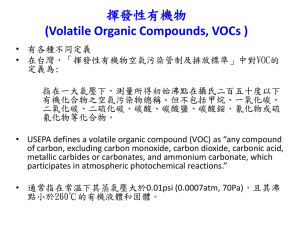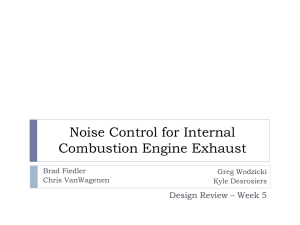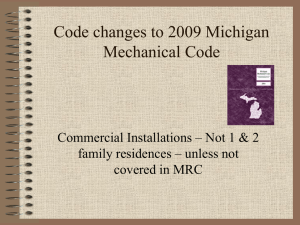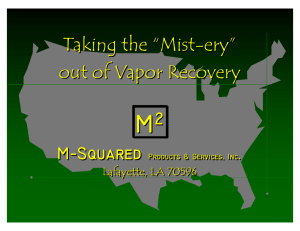EMISSION COMPLIANCE TEST PROTOCOL
advertisement
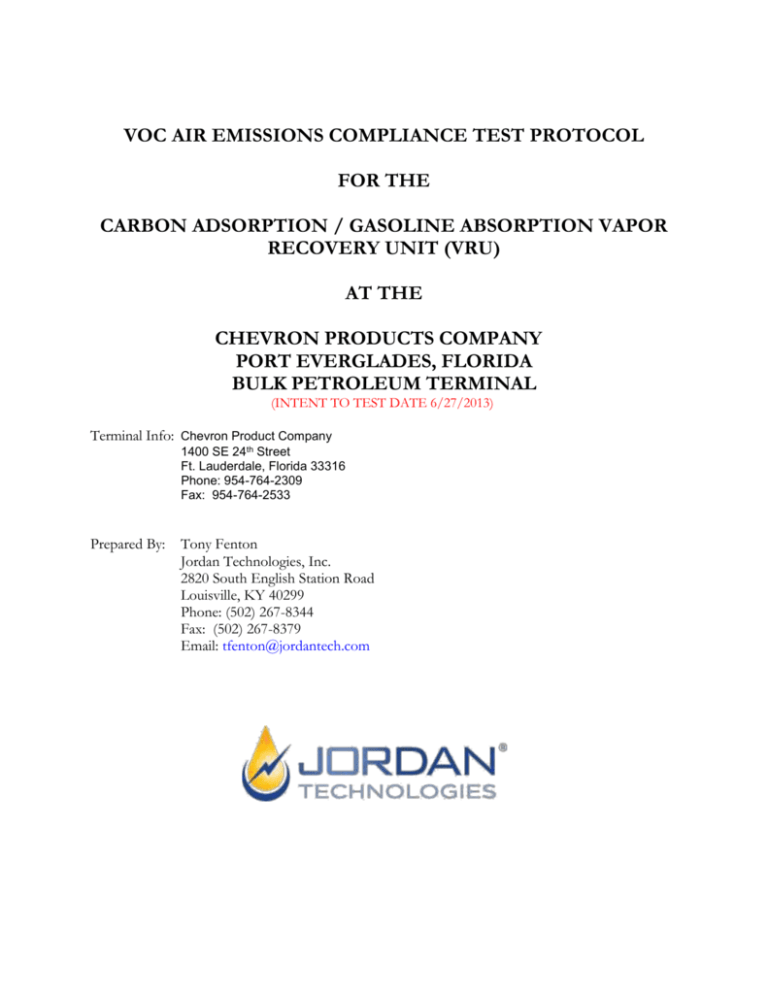
VOC AIR EMISSIONS COMPLIANCE TEST PROTOCOL FOR THE CARBON ADSORPTION / GASOLINE ABSORPTION VAPOR RECOVERY UNIT (VRU) AT THE CHEVRON PRODUCTS COMPANY PORT EVERGLADES, FLORIDA BULK PETROLEUM TERMINAL (INTENT TO TEST DATE 6/27/2013) Terminal Info: Chevron Product Company 1400 SE 24th Street Ft. Lauderdale, Florida 33316 Phone: 954-764-2309 Fax: 954-764-2533 Prepared By: Tony Fenton Jordan Technologies, Inc. 2820 South English Station Road Louisville, KY 40299 Phone: (502) 267-8344 Fax: (502) 267-8379 Email: tfenton@jordantech.com TABLE OF CONTENTS 1.0 INTRODUCTION 2.0 UNIT DESCRIPTION – VAPOR RECOVERY UNIT 3.0 VAPOR RECOVERY SCHEMATIC 4.0 TEST PROCEDURE 4.1 4.2 4.3 TEST EQUIPMENT TEST EQUIPMENT LAYOUT TEST TRAILER CHECK-VALVE DIAGRAM 5.0 TEST CALCULATIONS 6.0 QUALITY ASSURANCE 1 1.0 INTRODUCTION This test protocol document is presented in order to define the proposed air emissions testing of the Vapor Recovery Unit (VRU) installed at the truck loading rack at the Chevron Products Co. Port Everglades, Florida facility. This test is tentatively scheduled for June 27, 2013; however, that date is subject to revision based on any issues raised during review of this test protocol and scheduling requirements of the local air pollution control agency. This submittal constitutes the Notice of Performance Test required by 40 CFR 63.7(b), 63.9(e) and 63.11093(c) and is also the site-specific test plan required to be developed under 40 CFR 63.7(c). Testing is designed to satisfy NSPS 40 CFR 60, Subpart XX and 40 CFR 63, Subpart BBBBBB requirements. Testing will be performed to determine the emission rate for VOCs in units of milligrams of VOC (as Propane) per Liter of Accountable Product loaded and for estimated VOC Capture Efficiency, calculated based on inlet and exhaust concentrations. Specific Test Procedures that will be used are: EPA TEST METHOD MEASUREMENT Method 2A Method 25B (NDIR analyzer) Method 21 40 CFR 63 Subpart BBBBBB 63.11092(a)(1)(i) Exhaust Vapor Volume from VRU Inlet and Outlet VOC Concentrations as propane Potential Leak Sources Refer to 60.503 with addition of leak rate defined as 500 PPM Transport Loading Maximum Backpressure 40 CFR 60 Subsection 60.503 (d) The Jordan Technologies on-site testing technicians will be responsible for all sampling and final test report submittal. The final test report will be issued within 30 days of the field test. As required by 40 CFR 63.7(c)(2), this test protocol includes a test program summary the test schedule data quality objectives both an internal and external quality assurance program The test program summary and schedule are identified above and in sections 2.0 through 5.0 below; the data quality objectives and QA program are included in section 6.0. 2 2.0 CARBON ADSORPTION/GASOLINE ABSORPTION VAPOR RECOVERY UNIT Following is a brief description of the VRU process. For a fully detailed description please consult the manufacturer’s equipment manual. Hydrocarbon vapors, generated from truck loading, enter into one of two carbon adsorbers. The hydrocarbon and air vapors flow through the adsorber where the bulk of the hydrocarbons are adsorbed. The air continues through the carbon adsorber and is vented to the atmosphere. While this carbon adsorber is on-line processing the hydrocarbon vapors, the second carbon adsorber is off-line being vacuum regenerated (i.e. cleaned). The purpose of regeneration is to restore the carbon to a level where it will effectively adsorb hydrocarbons again. The two carbon adsorbers alternate between adsorption and regeneration at 15-minute intervals. When a carbon adsorber is being regenerated, the vacuum pump exerts a significant vacuum on the carbon adsorber vessel and desorbs the hydrocarbons from the carbon. The hydrocarbon vapors are then pumped from the carbon to the absorber tower. The hydrocarbons are condensed and absorbed by the counter flow liquid gasoline feed in the absorber tower and are then pumped back to the terminal’s gasoline storage tank. Any hydrocarbons that are not absorbed in the absorber tower pass up through the packed tower and are routed back to the on-line carbon adsorber. 3 3.0 VAPOR RECOVERY UNIT SIMPLIFIED SCHEMATIC Vapor Recycle Exhaust CLOSED OPEN Carbon Bed Pressure/Vacuum Relief Valve Carbon Bed Lean Gasoline Feed to Absorber Tower Absorber Tower Purge Air Inlet OPEN CLOSED Gasoline Vapors from Rack Vacuum Pump Enriched Gasoline Return to Tank The Jordan Service Co., Inc. Gasoline Storage Tank Gasoline Liquid Loading onto Transport Trucks 4 4.0 TEST PROCEDURE The Vapor Recovery Unit test will include testing to determine the quantity of VOC vapor emissions generated by the tank truck loading operations in accordance with the required test methodology contained in the Code of Federal Regulations Title 40 Parts 60 and 63 Vapor volume measurements will be obtained using EPA Method 2A. Method 25B (Methane Excluding) will be used for exhaust hydrocarbon concentration measurements, Method 25B for inlet hydrocarbon concentrations. Method 21 will be used for monitoring leaks in the vapor piping system, and the transport loading pressure will be monitored as described in sub-section 60.503 (d) (i.e., 18" water column gauge test). All sampling procedures will conform with the procedures outlined in New Source Performance Standards, (NSPS) 40 CFR 60, Subpart XX - Section 60.503 - Test Methods and Procedures and 40 CFR 63, Subpart BBBBBB – Section 63.11092(b)(1). Prior to beginning the compliance test, all vapor collection equipment, including fittings, vents and hoses will be tested with a portable LEL analyzer. Any leak equal to or greater than 500 PPM Volume (as Methane) shall be considered a leak, per 40 CFR 63.11092 (a). Any leaks detected above the limit, will be recorded on the field data sheets and they will be repaired prior to beginning the compliance test. The Inlet NDIR analyzer and Outlet NDIR analyzer will be calibrated using propane and nitrogen mixtures of approximately 0%, 25%, 50% and 85% of full scale. Calibration will be performed prior to beginning the test. During the test run, the 0% and 50% span gas will be introduced hourly to document that span and zero drift greater than 3.0% has not occurred. Data generated during the analyzer drift checks will be excluded from the final data set. The analyzer response speed is approximately 5.0 seconds for 90% of full scale deflection. All pertinent calibration data will be available for on-site inspection. The non-dispersive infrared analyzer, turbine flow meter, exhaust vapor thermistor and exhaust pressure transducer are connected to the VRU exhaust stack in order to acquire their respective data. A quad check valve assembly is employed to provide for proper VRU regeneration air flow and allow one turbine flow meter to satisfy both carbon vessel exhaust flow measurement requirements. The barometric pressure transducer and ambient thermistor are located in close proximity to the VRU to acquire ambient atmospheric conditions. Barometric pressure will be used in subsequent standardization equations. Inlet VOC concentrations will be monitored with an NDIR calibrated on 100% propane. This data will be recorded and analyzed as the data described above. Field data is monitored continuously and recorded every 5 minutes for printout as a test data point. The data is captured in a PLC and exported to an IBM compatible laptop computer running Wonderware software. The data monitored over the test period includes time, ambient temperature, exhaust meter temperature, barometric temperature, flow meter static pressure, inlet hydrocarbon concentration, exhaust hydrocarbon concentration, and exhaust flow rate. All of the accumulated data is downloaded into an Excel spreadsheet to calculate; standardized exhaust flow rate inlet hydrocarbon mass exhaust hydrocarbon mass At the end of testing, the Excel spreadsheet calculates the total mass of hydrocarbons emitted from the VRU during testing. The accountable liters loaded during the test are then used to calculate the mass of hydrocarbons per liter of gasoline loaded. The inlet and exhaust mass of hydrocarbons are used to estimate the VRU’s recovery efficiency. 5 Copies of the transport loading rack data sheets, hydrocarbon analyzer strip charts and computer printouts will be attached as Appendices to the final test report. 6 4.1 TEST EQUIPMENT Quantity Item 2 Thermistor Temperature Probes (Ambient and Exhaust Temperatures) 1 IBM compatible Laptop Computer with Allen Bradley PLC Data Acquisition System and Wonderware SCADA software 1 RKI Instruments Portable Hydrocarbon Analyzer (Meth. 21 Leak Test) 1 Setra Model #264 Differential Pressure Transducer (Flow Standardization) 1 Digital Barometer – Setra Model Datum 2270 (Flow Standardization) 1 American Meter Co. 8" Turbine Flow Meter (Method 2A Exhaust Flow) 1 Strip Chart Recorder: Yokogawa DX1000n Paperless Chart Recorder 1 Inlet NDIR Gas Analyzer, either: (Method 25B – Inlet VOC) Horiba VIA-500 Non Dispersive InfraRed Analyzer Enviromax Model 2010 NDIR 1 Outlet NDIR Analyzer, either: (Method 25B – Exhaust VOC) Horiba VIA-500 Non Dispersive InfraRed Analyzer Enviromax Model 2010 NDIR 1 Back Pressure Gauge: McDaniel Controls, Inc Model #20502A 7 4.2 TEST EQUIPMENT LAYOUT 8" Turbine Flowmeter VRU Exhaust Flow Inlet Vapors from Rack Inlet VOC Conc. VRU Barometric Pressure Ambient Temp. Exhaust Flow Pressure Exhaust Temp. Exhaust VOC Conc. Exhaust Flow Analog/ Digital Converter Personal Computer Data Acquisition System Wonderware SCADA Software Strip Chart Recorder (Records Inlet and Outlet Instantaneous Concentrations) Printer: Prints 5-Minute Data 8 4.3 TEST TRAILER CHECK-VALVE DIAGRAM Carbon VRU Outlet Sampling Locations 8" Flexible Hose Connected to Carbon Bed in a Leak Free Manner. Test Trailer 8" Flexible Hose Exhaust Pressure for Exhaust Volume Correction Exhaust VOC Analyzer Sample Exhaust Temperature for Volume Correction Carbon Bed One of Two (Only one shown) Two outer valves positioned to allow Carbon Beds to re-pressureize, and not back-flow through the Turbine Meter. Other Carbon Bed Connects Here Flow To Turbine Meter Flow Flow Flow Inlet Flow from Loading Rack Quad-Check Valve Assembly 9 5.0 TEST CALCULATIONS A. Terminology: Ta = Ambient Temperature ( o Celsius). Pb = Barometric Pressure (mm Hg). Lt = Total volume of liquid dispensed from all controlled racks during the test period (Liters). Ve = Volume of air-hydrocarbon mixture exhausted from the processing unit (cubic meters). Ves = Normalized volume of air-hydrocarbon mixture exhausted (Cubic meters at 20o Celsius, 760 mm Hg). Ce = Volume fraction of hydrocarbons in exhausted mixture (Volume % as C3H8/100, corrected for methane content, if required). Te = Temperature at process unit exhaust (o Celsius). Pe = Pressure at processing unit exhaust (mm Hg. absolute). Me = Mass of VOC emitted (milligrams). (M/L)e = Mass of hydrocarbons exhausted from the processing unit per volume of liquid loaded (mg/liter). (M/T)e = Mass of hydrocarbons exhausted from the processing unit per unit time (lb/hour). Constants: 0.3858 = (273.2o C + 20o C) / (760 mm Hg) Normalization Factor. 1.83 x 106 mg/m3 = Standard Density of Propane (C3H8). 454,000 = Conversion Factor mg/lb. 3.785 = Conversion Factor Liter/Gallon. 264.2 = Conversion Factor gallons / meter3 B. Calculate the Following Results for Each Period of the Vapor Control System Operation: (1.) Volume of air-hydrocarbon mixture exhausted from the vapor control system: Ve = (Vef - Vei) (meters3) (where subscript f refers to final and subscript i refers to initial) Ve = Totalized volume from flow rate and time records. (2.) Normalized volume of exhausted mixture: Ves = (0.3858o Kelvin/mm Hg) x Ve x Pe (meter3) (Te + 273.2) (3.) Mass of hydrocarbons exhausted from the vapor control system: Me = (1.83 x 106 mg C3H8) x (Ves) x (Ce) (mg) (Equation A) 3 meter 10 C. Calculate the Average Mass of Hydrocarbons Emitted Per Volume of Gasoline Loaded: (M/L)e = Me/Lt (mg/liter) D. Calculate the Average Mass of Hydrocarbons Emitted Per Unit Time: (M/T)e = (M/L)e x 1 lb x 3.785 liter x Acct. Gal (lb/hr) 454,000 mg 1 gal Test Time E. Calculation for Efficiency (if used): Unit Efficiency = [(Inlet Conc. – Outlet Conc.) / Inlet Conc.] x 100 Where inlet milligrams is derived using inlet concentration and volume of liquid loaded onto transports, assuming a vapor growth ratio of 1:1 and no leaks. F. Example Mass Emitted Calculation for a Typical Five Minute Interval: This is an example calculation only, and not an interval from this test. This is intended to clarify the computer method for arriving at the VOC mass emitted data for each test interval. Barometric Pressure (Baro-P) = 768.4 mm Hg Exhaust Pressure (Exhaust-P) = 1.0 mm Hg Ambient Temperature (Ambient-T) = 16.8o C Exhaust Temperate (Exhaust-T) = 18.3o C Volume Emitted Standardized (VES) = 43.6 m3 Volume Emitted (VE) = 42.9 m3 Milligrams Emitted (ME) = 436,931.5 mg Outlet VOC Concentration = 0.55 % Inlet VOC Concentration = 34.0 % Please Note: All data fields are rounded to two places following the decimal point for display purposes only. F1.) Therefore, for this calculation: 0.545 % lowest possible value before rounding for display Ce = 0.55 % value displayed (after rounding) 0.554 % highest possible value before rounding for display Ves = 43.55 m3 lowest possible value before rounding for display 43.6 m3 value displayed (after rounding) 43.64 m3 highest possible value before rounding for display F2.) Using the above values in the previous Equation A we have: Lowest Value (1.83 x 106) x (0.00545) x (43.55) = 434,345.9 mg Value calculated by Computer = 436,931.5 mg 6 Average Value (1.83 x 10 ) x (0.0055) x (43.6) = 438,834.0 mg 6 Highest Value (1.83 x 10 ) x (0.00554) x (43.64) = 442,431.0 mg Note: The value for Mass Emitted printed by the computer for this interval is 436,931.5 mg. While this is not the result produced from entering the printed values for HCout and VES into Equation A, it is the result produced by the calculation carried out on the stored computer data, prior to rounding for display. 11 6.0 QUALITY ASSURANCE The General Provisions of the National Emissions Standards for Hazardous Air Pollutants (40 CFR 63 Subpart 63.7(c)(2)(i)) that are required by Subpart BBBBBB define data quality objectives as the pretest expectations of precision, accuracy, and completeness of data. VRU missions are a function of ambient temperature, the types of products being loaded, and the loading rates. An additional factor greatly affecting the field data set is the variability of the truckload rack operation, both in number of trucks loaded and types of product being loaded. EPA’s test method requires only a single run for 6 hours (i.e., no duplicate runs); therefore, overall precision and accuracy are difficult to measure directly. However, our expectation is that the overall precision and accuracy are within ± 10% of the measured emission rate. We also expect to obtain a complete dataset of non-methane hydrocarbon concentrations, volumetric airflows, and the volume of gasoline loaded over the 6-hour period (excluding any mid-run calibrations). This dataset will include all raw field data including temperatures, pressures, barometric readings, etc. that are used in subsequent data reduction. Internal QA Program The General Provisions of the National Emissions Standards for Hazardous Air Pollutants (40 CFR 63 Subpart 63.7(c)(2)(ii)) that are referenced by Subpart BBBBBB for internal QA state that: “The internal QA program shall include, at a minimum, the activities planned by routine operators and analysts to provide an assessment of test data precision: an example of internal QA is the sampling and analysis of replicate samples.” Since the single 6-hour field test obviates the possibility of replicate samples, the only testing activity that can qualify as internal QA is the field calibration of the gas analyzers. All gas analyzers will be calibrated on-site prior to the beginning of the test. They will also be checked for acceptable drift on an hourly basis using the mid-range calibration gas and a final post test calibration will also be performed immediately following the test. All calibration gases will have a minimum certification of Primary Standard. Protocol One gases will be used if they are available in the gas analyzer range used. Additionally, the turbine meter, temperature probes, pressure gauge and barometer are calibrated on a routine basis biannually; The turbine meter is calibrated against a Meriam Model Z50MC2-6 Laminar Flow Element. The temperature probes are calibrated against a mercury thermometer in ice water, boiling water and one ambient temperature. The pressure transmitters are calibrated against a water manometer in the appropriate range. The electronic barometer is returned to the manufacturer for their calibration service. All calibration documentation will be provided in the final test report. 12 External QA Program The General Provisions of the National Emissions Standards for Hazardous Air Pollutants (40 CFR 63 Subpart 63.7(c)(2)(iii)) that are referenced by Subpart BBBBBB state that: “The external QA program shall include, at a minimum, application of plans for a test method performance audit (PA) during the performance test. The PA’s consist of blind audit samples provided by the Administrator and analyzed during the performance test in order to provide a measure of test data bias. The external QA program may also include systems audits that include the opportunity for on-site evaluation by the Administrator of instrument calibration, data validation, sample logging, and documentation of quality control data and field maintenance activities.” To the best of our knowledge there are no blind audit samples applicable to the measurement of gasoline vapors. With the variability of the gasoline composition this would appear to be extremely difficult to enact. Therefore, this section does not seem to pertain to the VRU emission field test. Sample Custody All sampling, measurements, calibrations and data analysis will take place during the actual test period in real time mode. There will be no discrete samples taken for off-site analysis and therefore no chain of custody procedures or paperwork is required. 13

